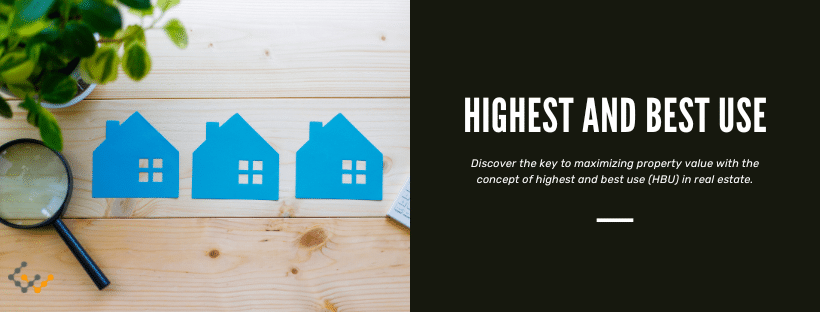How to Determine the Highest and Best Use of a Property

Commercial real estate investors are generally familiar with appraisals, which seek to value a property accurately. Appraisals are used for home purchases, vacant land purchases, commercial real estate purchases, and the evaluation of most other properties.
The highest and best-use appraisal (HBU appraisal) is especially important in commercial real estate. This specific type of appraisal calculates property value according to how a property can be used.
What is Highest and Best Use in Real Estate?
Highest and best use refers to a property’s most financially advantageous use. However, a property that might be legally, pragmatically, and productively used is evaluated, and the best case for investors is chosen as the basis for appraisal.
In other words, HBU answers, “What is the best way to use this property to get the most value from it?”
Since investors are presumed to seek the greatest financial value from a property, the HBU is often the most appropriate use case for determining value.
4 Criteria that Highest and Best Use Must Meet
Highest and best use isn’t some vague notion that property investors feel in their gut. Instead, the concept is well-defined so that investors, owners, buyers, sellers, managers, and real estate agents can effectively discuss this appraisal type.
Specifically, HBU must meet four formal criteria: legal permissibility, physical possibility, financial feasibility, and maximum profitability.,
Legal Permissibility
Before any other factor, the use of a property must be legally permissible. This means it should comply with zoning laws, environmental regulations, building codes, and any other legal restrictions that apply to the property.
The most common legal permissibility issues are zoning regulations and, to a lesser extent, building codes. Investors looking at specialized properties (e.g. properties with hazardous materials, properties for logging, etc.) and/or buildings in areas with high population densities might have additional restrictions to check.
Investors with common (e.g. multifamily) properties in unincorporated areas have very few regulations to consider.
Analyzing local, state and federal legal restrictions ensures the proposed use of a property won’t have to stop operations due to some law or regulation.
Physical Possibility
The property must be physically capable of supporting the intended use. For example, a skyscraper may not be physically possible on a small, narrow plot of land. The physical constraints of the property, including size, shape, terrain, and location, among others, should be carefully evaluated to assess physical possibility.
Again, physical possibility is often inconsequential if a property is to have a smaller building on a basic plot of land.
If a property is to have large buildings, specialized buildings or specialized operations, however, physical restrictions require more consideration. Not only must investors consider any buildings, but also how operations will be conducted and how the property will be accessed.
Financial Feasibility
An intended use that is both legally permissible and physically possible must also be financially feasible.
The cost to develop or change the property should not exceed its potential income or resale value. If a proposed use isn’t financially viable, it doesn’t qualify as the highest and best use because that wouldn’t ultimately provide the best returns.
Importantly, an investor’s financial resources don’t necessarily limit financial feasibility. The feasibility is primarily determined by whether the returns would exceed the costs, regardless of what investor pays those costs. Appraisals aren’t based on investors, but properties and possibilities in this case.
Maximum Profitability
Among all feasible uses, the highest and best use is the one that generates the greatest net return over a period. The goal is not just to make the property usable, but to ensure it brings in maximum profitability for the investor.
Profitability may come in the form of revenues, appreciation or other increases in value.
Examples of How Highest and Best Use is Applied
How highest and best use is determined depends on the type of property being appraised. The following gives some examples of how investors might evaluate HBU.
Highest and Best Use on Vacant Land
For vacant land located in rapidly developing residential areas, the highest and best use may be to develop the land as multi-unit residential or mixed-use. Zoning laws (legal permissibility), location (physical accessibility) and market demand (financial feasibility) are some major considerations.
If the vacant land is in an undeveloped and rural area, the HBU may be agricultural, logging, manufacturing or some similar use. Physical possibility is a major consideration, as the topography of, resources on, and accessibility to the land are determinants.
Highest and Best Use on Improved Property
For improved properties, the HBU may involve repurposing the building. A warehouse in a gentrifying neighborhood might be more valuable if converted into lofts or a shopping center. A dilapidated multifamily building might still be best used as housing, but HBU could be affected by how the property is renovated.
Local zoning laws can factor in when changing property use, such as warehouse to housing. Otherwise, financial feasibility and maximum profitability are primary considerations.
Highest and Best Use on New Construction
In the case of new constructions, the HBU could be determined by the prospective demand for a certain property type. For example, in an area where office spaces are in high demand, the HBU for a new construction project might be a commercial building rather than a residential one. That could be another office building or a different commercial property that serves all the workers in the area.
Financial feasibility and maximum profitability are primary considerations, as local zoning laws are less of an issue if a similar building is being constructed.
When multifamily housing is being built, maximum profitability will be impacted by the number of units, type of units, and whether commercial spaces are included in the development. This can involve zoning laws and maximum profitability.
How Do Commercial Appraisers Determine a Property’s HBU?
Commercial property appraisers use several methods to determine a property’s highest and best use.
They conduct a thorough market analysis, reviewing current and anticipated market conditions, demographic trends, and economic indicators. Both the costs and potential returns associated with each possible use, revenue forecasts, cost estimates for developing the property, and potential profit margins are projected.
A risk analysis is frequently completed to evaluate what issues could affect use and profitability.
Of course, all potential uses must meet the legal and physical requirements noted above. Appraisers check these, but most work involves calculating costs and returns.
The appraiser’s role is to combine all these factors to determine the highest and best use, which is then used as the basis for property valuation.
Wrapping Things Up
The concept of highest and best use is fundamental in real estate appraisal, shaping the way properties are valued, bought and sold, and developed. The highest and best use analysis serves as a strategic guide for property owners, investors, and developers to maximize the profitability of their properties, ensuring that they are used in the most efficient, effective, and value-enhancing way.
Whenever you try to assess how much a property could be worth, make sure you’re completing a thorough HBU appraisal.

